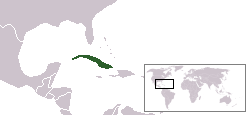 W
WLepidoptera of Cuba consist of both the butterflies and moths recorded from the island of Cuba.
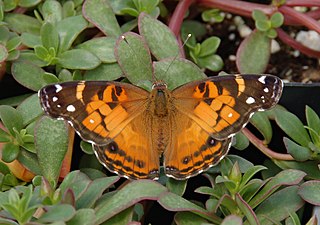 W
WThe American painted lady or American lady is a butterfly found throughout North America.
 W
WAnteos clorinde, the white angled-sulphur, is a butterfly of the family Pieridae. It is found in South America, Central America, and southern North America.
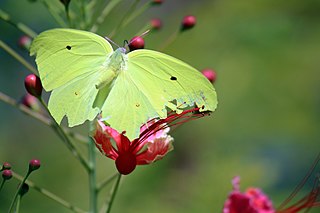 W
WAnteos maerula, the angled sulphur or yellow angled-sulphur, is a butterfly of the family Pieridae. It is found from Peru to Mexico. Rarely, migrants can be found up to eastern Nebraska, south-eastern Arizona, south-western New Mexico, southern Texas, Mississippi and Florida.
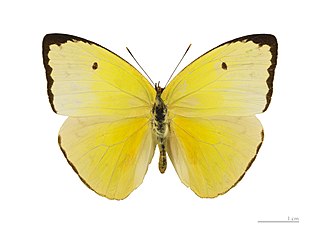 W
WAphrissa statira, the statira sulphur, is a species of Lepidoptera in the family Pieridae. The species is a medium-sized yellow butterfly, with females more pale than males. They are found from southern regions of Florida and Texas through southern Brazil and northern Argentina. The caterpillars feed on the leaves of several local host plants, while adults prefer to feed on the nectar of red or orange colored flowers. The species is most noted for their dramatic migrations in the tropical areas of the Americas. They have been the subject of many studies about how butterflies navigate and orient during migration.
 W
WAsterocampa idyja, the cream-banded emperor, is a species of butterfly in the family Nymphalidae.
 W
WBattus polydamas, also known as the gold rim swallowtail, the Polydamas swallowtail or the tailless swallowtail, is a species of butterfly in the family Papilionidae. The species was first described by Carl Linnaeus in his 10th edition of Systema Naturae, published in 1758.
Calisto bradleyi is a butterfly of the family Nymphalidae. It is endemic to Cuba, where it is found in the major mountain range of western Cuba, Guaniguanico, from El Taburete, at Sierra del Rosario, west to Viñales valley, always at low elevations. The species inhabits various vegetation types throughout its distribution but can only be found in areas where original elements are still dominant.
Calisto brochei is a butterfly of the family Nymphalidae. It is endemic to Cuba, where it is present in several localities in the middle and western Nipe-Sagua-Baracoa mountains, from the Monte Iberia plateau west to the Pinares de Mayarí at Nipe plateau. The species inhabits several variants of rain and evergreen forests at altitudes between 200 and 800 meters. Individuals can be found mainly at shady forest paths.
Calisto bruneri is a butterfly of the family Nymphalidae. It is endemic to Cuba, where it occurs in the western parts of the Nipe-Sagua-Baracoa Mountains. The species inhabits rainforests, wet sclerophyllous low forests and pine forests.
Calisto israeli is a butterfly of the family Nymphalidae. It is endemic to Cuba, where it is known from the middle and western parts of the Nipe-Sagua-Baracoa mountains, from the Monte Iberia plateau west to Cupeyal. The species has also been recorded from Sierra de Cristal. It is probably also present on the eastern half of Nipe-Sagua-Baracoa mountains. It can be found from 250 and 1,230 meters, where it inhabits several variants of evergreen and rainforests and, to a lesser extent, wet sclerophyllous low forests.
Calisto muripetens is a butterfly of the family Nymphalidae. It is endemic to Cuba, where it is only known from a few localities in the central Cuban mountains: the Guamuhaya massif, above 750 meters and up to 1,140 meters on Pico San Juan, the highest peak. The species inhabits evergreen forests of the mogotes vegetation complex, limestone hills of vertical slopes, and rainforests, flying mostly in shady places.
Calisto occulta is a butterfly of the family Nymphalidae. It is endemic to Cuba, where it is known from a few localities from the middle part of the Nipe-Sagua-Baracoa mountains, from the Monte Iberia plateau north to near Yamanigüey, in north-eastern Cuba. It is probable that it is more widespread in the Nipe-Sagua-Baracoa mountains. The species inhabits the wet sclerophyllous low forests and rainforests up to 700 meters in the Nipe-Sagua-Baracoa mountain range.
Calisto israeli is a butterfly of the family Nymphalidae. It is endemic to Cuba, where it is known from the Sierra Maestra. The species inhabits evergreen and rainforests at altitudes between 800 and 1,500 metres. It is also found in cloud forest above 1,500 metres, and at the cloud scrub around Pico Turquino.
 W
WChlorostrymon simaethis, the silver-banded hairstreak, is a North and South American butterfly in the family Lycaenidae. It is also known as St. Christopher's hairstreak and the Key lime hairstreak.
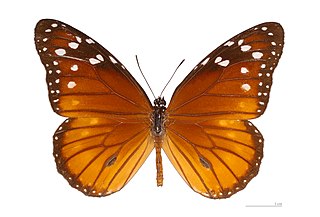 W
WDanaus eresimus, the soldier or tropical queen, is a North American, Caribbean, and South American butterfly in the family Nymphalidae.
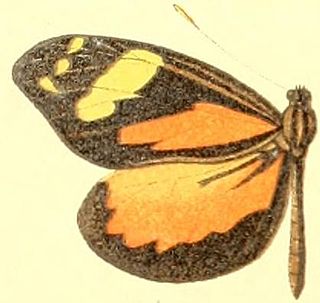 W
WDismorphia cubana, the Cuban dismorphia, is a butterfly in the family Pieridae. It is endemic to Cuba.
 W
WDoxocopa laure, the silver emperor, is a species of butterfly of the family Nymphalidae.
 W
WDynamine postverta, the Mylitta greenwing or four-spot sailor, is a butterfly in the family Nymphalidae. It is found throughout most tropical and subtropical areas of Central and South America, from Mexico south to Argentina and Paraguay. The habitat includes primary rainforests, humid deciduous woodlands, scrubby grassland and farmland at altitudes up to about 900 metres.
 W
WEumaeus atala, the Atala or coontie hairstreak, is a small colorful butterfly in the family Lycaenidae. It is found in southeastern Florida, the Bahamas, Cuba, the Cayman Islands, and probably on other Caribbean islands. Its coloration and habits are unique among butterflies within its range.
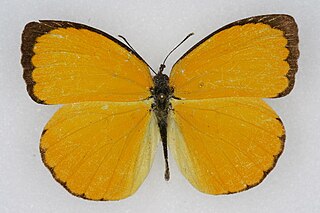 W
WEurema dina, the dina yellow, is a butterfly in the family Pieridae. The species was first described by Felipe Poey in 1832. It is found from Panama north to southern Florida. The species is regularly recorded from southern Texas and south-eastern Arizona. The habitat consists of forest edges, brushy fields and open forest.
 W
WEurema lisa, commonly known as the little yellow, little sulphur or little sulfur, is a butterfly species of subfamily Coliadinae that occurs in Central America and the southern part of North America.
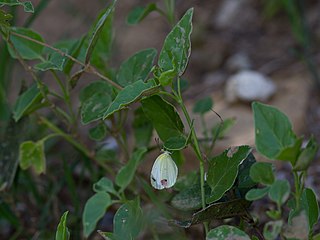 W
WEurema messalina, the shy yellow, is a butterfly in the family Pieridae. It is native to the West Indies, but a very rare stray may be found in southern Florida. The habitat consists of shady, brushy areas.
 W
WEurema nicippe, the sleepy orange, is a North American butterfly in the family Pieridae. It is also found in the West Indies, Costa Rica and Belize.
 W
WEurema proterpia, the tailed orange, is a North and South American butterfly in the family Pieridae.
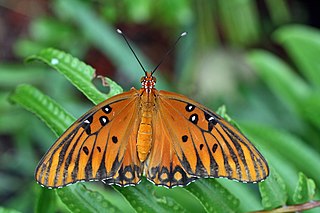 W
WThe Gulf fritillary or passion butterfly is a bright orange butterfly in the subfamily Heliconiinae of the family Nymphalidae. That subfamily was formerly set apart as a separate family, the Heliconiidae. The Heliconiinae are "longwing butterflies", which have long, narrow wings compared to other butterflies. Gulf fritillary is the only member of genus Agraulis.
 W
WHamadryas amphinome, the red cracker, is a species of cracker butterfly in the family Nymphalidae, native to regions of North and South America.
 W
WHamadryas feronia, the blue cracker or variable cracker, is a species of cracker butterfly in the family Nymphalidae. It is found in the southern parts of North America and southwards to Brazil.
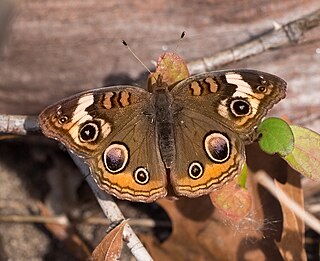 W
WJunonia coenia, known as the common buckeye or buckeye, is a butterfly in the family Nymphalidae. It is found in all parts of the United States except the northwest, and is especially common in the South, the California coast, and throughout Central America. Its habitat is open areas with low vegetation and some bare ground. Its original ancestry has been traced to Africa, which then experiences divergence in Asia.
 W
WJunonia evarete, the Tropical Buckeye or West Indian buckeye, is a Neotropical butterfly of the Nymphalids (Nymphalidae) family. It has characteristic eye spots on the wings, which have a wingspan between 4.5 and 6.5 cm. This butterfly is easily confused with Junonia genoveva, the mangrove buckeye. Not only have the common names mangrove and tropical buckeye been confused, but the butterflies themselves have been sometimes misidentified in past literature, because the two species have many variations, subspecies and seasonal forms, which makes it difficult to identify or differentiate. Phylogenetic studies demonstrate the separation of evarete and genoveva, but evidence suggests that subspecies and perhaps additional species await their descriptions within this group.
 W
WJunonia genoveva, the mangrove buckeye, is a butterfly of the family Nymphalidae. The species was first described by Pieter Cramer in 1780. It is found in North America from southern New Mexico, southern Arizona, southern Texas, and southern Florida south through the West Indies, Mexico and Central America to Argentina. Rare strays can be found up to southeastern California, southeastern Colorado and central Florida. In the Cayman Islands, it is known as the Caribbean buckeye.
 W
WMarpesia eleuchea, the Antillean daggerwing, is a species of butterfly of the family Nymphalidae. It is found in the West Indies. Occasional strays can be found in the Florida Keys.
 W
WNathalis iole, the dainty sulphur or dwarf yellow, is a North American butterfly in the family Pieridae.
 W
WPapilio andraemon, the Bahaman swallowtail, is a swallowtail butterfly of the subfamily Papilioninae. It is found on the Bahamas, Cuba, Jamaica and the Cayman Islands. It is a rare stray or temporary colonist of the Florida Keys or the mainland near Miami.
 W
WPapilio androgeus, the Androgeus swallowtail, queen page, or queen swallowtail, is a Neotropical butterfly of the family Papilionidae. It is found from Mexico to Argentina with a small population in southern Florida.
 W
WPapilio caiguanabus, the Poey's black swallowtail, is a species of Neotropical butterfly in the family Papilionidae. It is endemic to Cuba.
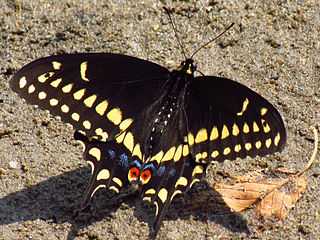 W
WPapilio polyxenes, the (eastern) black swallowtail, American swallowtail or parsnip swallowtail, is a butterfly found throughout much of North America. It is the state butterfly of Oklahoma and New Jersey. An extremely similar-appearing species, Papilio joanae, occurs in the Ozark Mountains region, but it appears to be closely related to Papilio machaon, rather than P. polyxenes. The species is named after the figure in Greek mythology, Polyxena, who was the youngest daughter of King Priam of Troy. Its caterpillar is called the parsley worm because the caterpillar feeds on parsley.
 W
WPapilio thoas, the king swallowtail or Thoas swallowtail, is a butterfly of the family Papilionidae. It is found in the southernmost United States, Mexico, Central America and South America. The species is easily confused with the giant swallowtail, which it closely resembles in both larval and adult stages. The caterpillars feed on the leaves of citrus plants (Rutaceae). They have also been reported as feeding on a member of the genus Piper.
 W
WParides gundlachianus, the Cuban cattleheart, is a species of butterfly in the family Papilionidae. It is an endemic species found only in Cuba. The name honours the Cuban naturalist Juan Gundlach.
 W
WPhoebis avellaneda, the red-splashed sulphur, is a large, striking yellow butterfly in the family Pieridae. It is an endemic species found only in Cuba.
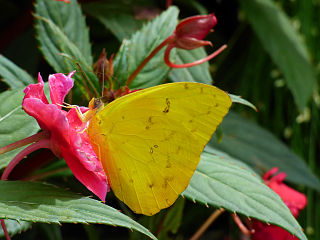 W
WPhoebis philea, the orange-barred sulphur, is a species of butterfly found in the Americas including the Caribbean.
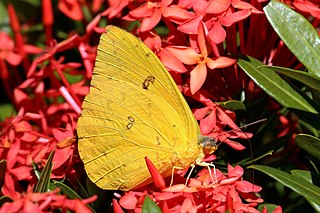 W
WPhoebis sennae, the cloudless sulphur or cloudless giant sulphur, is a mid-sized butterfly in the family Pieridae found in the Americas. There are several similar species such as the yellow angled-sulphur, which has angled wings, statira sulphur, and other sulphurs, which are much smaller.
 W
WPontia protodice, the checkered white or southern cabbage butterfly, is a common North American butterfly in the family Pieridae. Its green larva is a type of cabbage worm.
 W
WProtographium celadon, the Cuban kite swallowtail or Celadon swallowtail, is a butterfly of the family Papilionidae. It is endemic to Cuba. Occasional strays can be found on the Florida Keys.
 W
WPseudochrysops is a genus of butterflies in the family Lycaenidae. This genus is monotypic, consisting of only one species, Pseudochrysops bornoi, which is found on Haiti, Puerto Rico and Cuba.
 W
WPyrisitia nise, the mimosa yellow, is a butterfly in the family Pieridae. It is found from Argentina north to the Texas Gulf Coast and throughout central and southern Florida, northward to the Tennessee Valley. It is an occasional stray to central Texas and south-eastern Arizona and rarely to southern California, southern Colorado and Kansas. The habitat consists of brushy woodland edges.
 W
WThe Salvin's anetia is a species of nymphalid butterfly in the Danainae subfamily. It is endemic to Cuba.
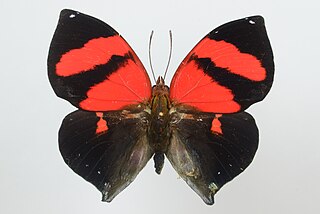 W
WSiderone galanthis, the scarlet leafwing or red-striped leafwing, is a species of butterfly of the family Nymphalidae. It is found from Mexico to southern Brazil. The habitat consists deciduous and evergreen forests at altitudes up to 900 meters.
 W
WStrymon bazochii, the lantana scrub-hairstreak or smaller lantana butterfly, is a butterfly in the family Lycaenidae. It is found from Paraguay north through Central America, the West Indies and Mexico to southern Texas. It was introduced to Hawaii in 1902 to control Lantana species, in which it has proven unsuccessful.
 W
WStrymon istapa the mallow hairstreak, mallow-scrub hairstreak, dotted hairstreak or Hewitson's hairstreak. This diurnal butterfly is a widespread species that can be found in xeric habitats throughout the southern United States, Central America, parts of the Caribbean, and rarely in South America. This species can be spotted in rural and suburban areas in which human infringement has created open fields or tracks of overgrown weeds as a result of land clearing. These butterflies are often seen rubbing their hindwings together presumably to attract attention to their antenna mimicry scales located on the outer margin of the hindwing.
 W
WWallengrenia otho, the southern broken dash or broken dash skipper, is a butterfly of the family Hesperiidae. It was originally described by Smith in 1797. It is found from eastern Texas and the southeastern United States, south through the West Indies and Central America to Argentina. Strays can be found as far north as central Missouri, northern Kentucky and Delaware.
 W
WZerene cesonia, the southern dogface, is a North and South American butterfly in the family Pieridae, subfamily Coliadinae.